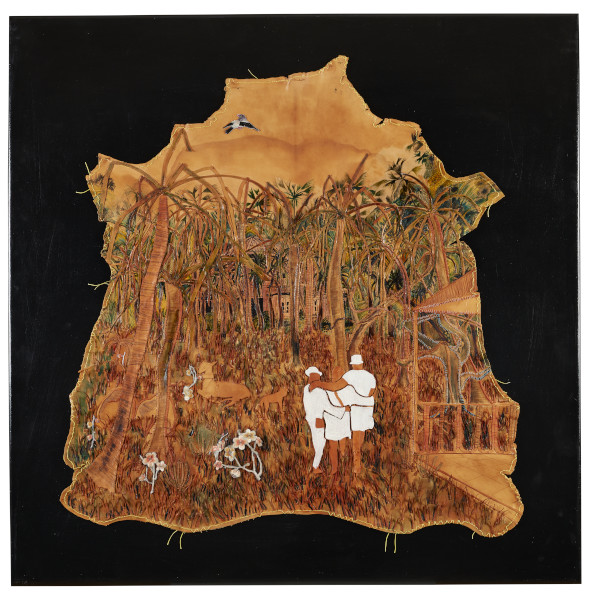The Sacrifice (2023.14)
Catalogue Record
Collection
Maker
Moses Quiquine
Title
The Sacrifice
Date
2018
Materials and techniques
The piece is made from veg Tan untreated goat skin leather which had also been ceiled with wood varnish. The coloring and pigments are liquid based leather dyes- the brand is called Fiebing. The embroidery is silk thread. I have used quite industrial or resilient products so technically should be very robust. I hope this is helpful information
White acrylic paint on goat hide (veg tan leather). Silk thread hand stitchings on goat hide. Leather cuttings and silk embroidery glued (UHU contact adhesive) on goat hide. Leather dye on goat hide.
Tools:
Leather sewing awl, leather needles, scissors, paint brush, leather cutting
tools.
White acrylic paint on goat hide (veg tan leather). Silk thread hand stitchings on goat hide. Leather cuttings and silk embroidery glued (UHU contact adhesive) on goat hide. Leather dye on goat hide.
Tools:
Leather sewing awl, leather needles, scissors, paint brush, leather cutting
tools.
Dimensions
length: 120cm
width: 120cm
Object number
2023.14
Category
Alt Category
New Positions for the Crafts Council Collection
For other objects in this category click the linked text.
For other objects in this category click the linked text.
Credit
Acquired with Art Fund support, donations by Preston Fitzgerald and Cedric Smith, and Nicholas and Judith Goodison’s Charitable Settlement
Maker's statement
The Sacrifice, created on goatskin, represents a process of simultaneously aesthetic and psycho-spiritual alchemy. The memory had at its centre the feeling of something terrible. Having established a routine with his sister of going along to feed the same local goat every day, the two children were one day to discover a menacing dog hanging from the goat’s neck. ‘There were no adults around,’ he recalls, ‘just me, my sister, the dog and the dying goat. The work, supposed to be the artistic representation of a gruesome, bloody memory, unexpectedly filtered through a creative consciousness that is both aware of trauma having taken place and also concerned to inject an energy that is in some way healing, ends up being another image of post-traumatic ‘three-ness’: a serenely passive goat-deer, on its way, perhaps, to death; an observing canine consciousness, no longer necessarily the butcher of the scene, but instead, perhaps, its key witness; and a divinely human, self-healing collective, itself split (but reconnected) into three distinct consciousnesses. Some kind of cosmic alteration has taken place through the creative process, enabling ‘sacrifice’ to be averted, and communication to become possible. ‘It’s the piece people gravitate to most’, says Quiquine, ‘they seem to like its warmth.’






